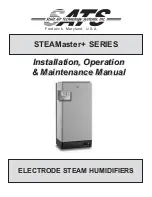
Clean the drain valve; start with a fresh cylinder.
Then measure the manual drain time with and without
the external drain connected. Is the external drain
impeding flow? NORTEC recommends an open
external drain line. See Form #XX-161.
NHMC/NHP
The self-diagnostic system built into the NHMC is
continually checking the status of the electrical circuits
to the fill valve, drain valve, primary voltage contactor,
high water sensor and steam cylinder. The modulating
signals from external humidistats and reduced manual
capacity settings are taken into consideration. When
problem symptoms are found, the NHMC/NHP will
take self-corrective actions, if applicable. It will, if
necessary, respond by shutting itself down.
The NHMC/NHP communicates its findings to the
user by way of the unit’s status lamps and signals sent
to the terminal strip for optional external remote
indication.
Even more directly, the NHMC has an
alphanumeric system message to the user via the
LCD (liquid crystal display).
All of this is summarized for each system message
in the following easy-to-follow format.
NHMC/NHP Explanation of System Messages and
Responses —- EPROM : 2.XXN
1. Maximal Level (Shown on NHMC LCD display
only)
Symptom(s) Diagnosed: Water has reached the
top of the cylinder and activated the high water
sensor circuit. This is not an error or fault
diagnostic. Note: This is normal on start-up and
at end of cylinder life before Error 4 shows.
Probable Cause(s): Normal on startup with a
new cylinder or a cylinder that has been
completely drained because of an extensive off
period. Can last for several hours until the water
in the cylinder has concentrated or the electrodes
can no longer provide rated capacity (or adjusted
capacity). Water level automatically rises to seek
out fresh electrode surface to meet the demand.
Unit Takes Self-Corrective Action: Yes. It stops
the fill valve to prevent overfilling.
2. Excess Current - Error 1
Symptom(s) Diagnosed: Current drawn on
monitored primary lead to cylinder has reached or
exceeded 125% of its rated amps. The unit will
have tried to self-correct prior to system shutdown
by draining water from the cylinder or
de-energizing the contactor momentarily while it
drains.
Probable Cause(s):
1.
Cylinder water is over-concentrated (too
conductive) due to restricted drain, short-cycling
by controls, supply water not within acceptable
limits (too conductive), improper fill rate, incorrect
cylinder being used.
2.
Water level too high due to leaking fill valve,
excess condensate return from steam line.
Corrective Action:
1.
Note water level.
2.
Manually drain cylinder while checking drain rate
(refer to Figure #7 for proper drain times). If too
slow correct cause.
3.
Turn unit back on and check the fill rate (1 - 1-1/2
inches per minute)
4.
Once RH% set point is attained, monitor cycle
time.
Response: See Figure #2, NHMC/NHP System
Messages
3. No Current - Error 2
Symptom(s) Diagnosed: Full cylinder (MAXIMAL
LEVEL) detected with no current draw sensed by
the electronics on monitored primary lead to
cylinder.
Probable Cause(s):
1.
No current being drawn, specifically on the
monitored primary lead to the cylinder, or the
actual current not being sensed.
2.
False detection of a full cylinder (water level within
inches of cylinder top) due to foaming,
wiring/connection problem, circuit board failure.
Corrective Action: Check water level in cylinder.
1.
If full (within 4" of top) disconnect white sensor
plug on cylinder, reset unit and check monitored
primary lead to cylinder for current with amp
clamp. If current present, determine why main
PCB does not sense the current. If no current,
present determine cause of primary voltage
interruption.
2.
If not full disconnect white sensor plug on cylinder,
reset unit. If error 2 does not reoccur within two
minutes, cylinder was likely foaming and should be
flushed. If error 2 does reoccur within two
minutes, there is a problem with the high water
sensor PCB. If error 2 occurs with the high water
sensor PCB disconnected, there is a problem with
the main PCB.
- 16 -
Summary of Contents for 132-3091
Page 34: ... 31 ...
Page 36: ... 33 ...
















































